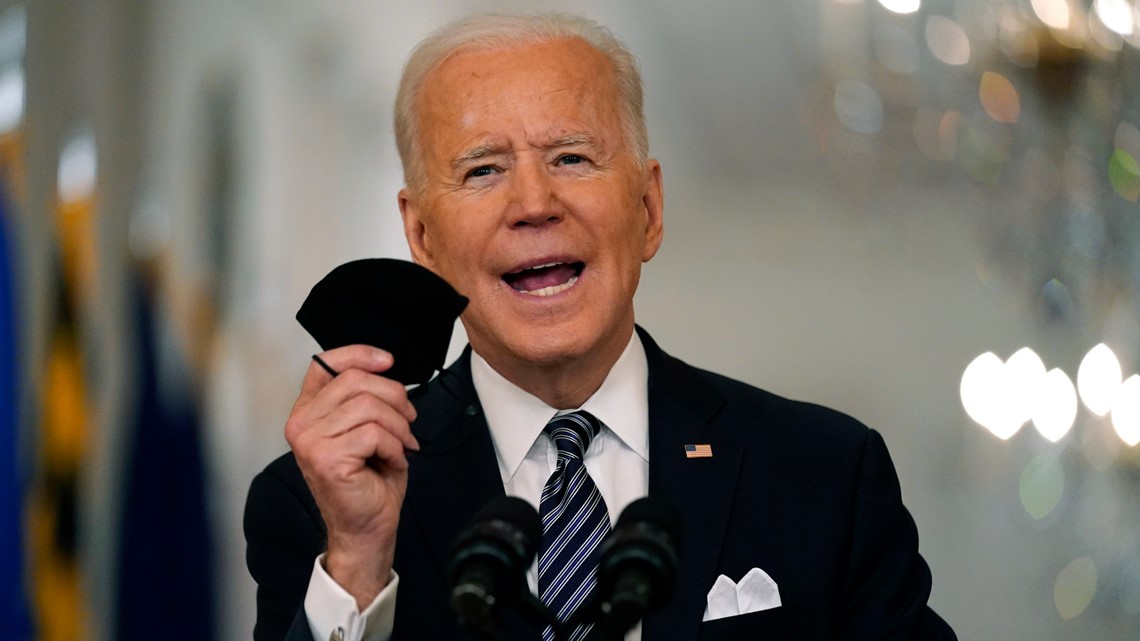WASHINGTON — The White House is trying to overcome diminishing demand for COVID-19 shots by offering businesses a tax incentive to give employees paid leave to get vaccinated. The move comes as the United States is set to meet President Joe Biden's goal of administering 200 million coronavirus doses in his first 100 days in office.
With more than 50% of adults at least partially vaccinated and roughly 28 million vaccine doses being delivered each week, demand has eclipsed supply as the constraining factor to vaccinations in much of the country.
Over the last week, the pace of inoculation in the U.S. has slowed slightly. That is partly a reflection of disruptions from the “pause” in administration of the Johnson & Johnson shot for a safety review, but also of softening interest for vaccines in many places even as eligibility has been opened to all those older than 16.
As the vaccination program progresses, the administration believes it will only get more difficult to sustain the current pace of about 3 million shots per day. Roughly 130 million Americans have yet to receive one dose.
In a White House speech on Wednesday, Biden will discuss efforts to expand vaccine distribution and access in his first three months in office, and outline his administration's latest plans to motivate more Americans to get shots.
Surveys have shown that vaccine hesitancy has declined since the rollout of the shots, but administration officials believe they have to make getting vaccinated easier and more appealing, particularly for younger Americans who are less at risk from the virus and do not feel the same urgency to get a shot. That means providing incentives and encouragement to get vaccinated, as well as reducing the friction surrounding the vaccination process.
Biden announced the launch of a tax credit for small businesses to provide paid leave for those getting vaccinated or potentially needing to take time off to recover from side effects. Paid for through the $1.9 trillion virus relief package passed last month, the tax change would provide a credit of up to $511 per day, per employee for businesses with fewer than 500 workers to ensure that those workers or businesses don't suffer a penalty by getting vaccinated.


The White House is calling on larger employers, which have more resources, to provide the same benefits to their employees, and to institute vaccine education and encouragement campaigns so that their workers get shots.
According to the White House, just 43% of working adults have received at least one shot.
Asked about the dip in vaccinations, Health and Human Services Secretary Xavier Becerra said “fluctuation is not uncommon” and that “what we want to do is continue to encourage Americans to get vaccinated.”
“The pace of vaccination isn’t linear,” Becerra said, adding that “we are on a pretty good pace.”
Through its partnership with more than 40,000 retail pharmacies, the White House says more than 90% of Americans now live within 5 miles of a vaccination site, and the administration is encouraging state and local efforts to bring vaccines directly to people, whether through initiatives reaching the homebound or clinics at large employment sites.
Many states have also begun to open up vaccination sites to walk-in appointments, reducing reliance on often-cumbersome reservation systems.
Maximizing the number of Americans vaccinated in the coming months is critical for the White House, which is aiming to restore a semblance of normalcy around the July Fourth holiday and even more so by the beginning of the next school year.
Biden was not expected to set new public targets for vaccinations, and administration officials have been careful to avoid predicting when the country will have vaccinated enough people to reach herd immunity — when enough people become immune to a disease to make its spread unlikely. The U.S. is on track to have enough vaccine supply for every adult by the end of May and for every American by July, but administering the shots will be another matter.
In recent weeks the White House has launched a massive outreach campaign to Americans to get vaccinated, relying on funding from the relief bill to launch ads and fund direct community engagement to under-vaccinated constituencies.
Biden set his goal of 200 million shots last month after meeting his 100 million-in-100 days goal just over a month ago. At the time the U.S. was well on pace to meet the higher target, and the pace of vaccinations has only accelerated, to about 3 million shots per day.
The 100 million-dose goal was first announced on Dec. 8, days before the U.S. had even one authorized vaccine for COVID-19, let alone the three that have now received emergency authorization. Still, it was generally seen within reach, if optimistic.
By the time Biden was inaugurated on Jan. 20, the U.S. had already administered 20 million shots at a rate of about 1 million per day, bringing complaints at the time that Biden’s goal was not ambitious enough. Biden quickly revised it upward to 150 million doses in his first 100 days.
It was a deliberate effort by Biden to set clear — and achievable — metrics for success as part of a strategy of under promising, then overdelivering. Aides believe that exceeding his goals breeds trust in government after the Trump administration’s sometimes fanciful rhetoric on the virus.

